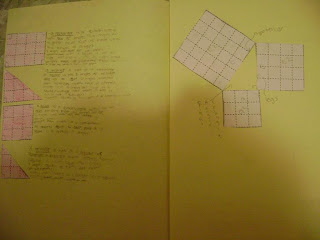 y that could be of use to us.
y that could be of use to us.The legs are the shorter part of a right angle triangle, while the hypotenuse is the longer part of a right angle triangle.
 The three pictures are linked together because it has to with the Pythagorean Theorum. The Pythagorean therum tells us the relationship between the legs and hyptonuse of a right angle triangle, that is why there is a picture of a right angle triangle in the post (we know it is a right angle because of the square at the corner). There is a picture of a square because in the Pythagorean Theorum you make multiple right angles, resulting in a square. The last picture is of Pythagoras himself, or rather a sculpture of him. It was his theorum, so that is why he is there.
The three pictures are linked together because it has to with the Pythagorean Theorum. The Pythagorean therum tells us the relationship between the legs and hyptonuse of a right angle triangle, that is why there is a picture of a right angle triangle in the post (we know it is a right angle because of the square at the corner). There is a picture of a square because in the Pythagorean Theorum you make multiple right angles, resulting in a square. The last picture is of Pythagoras himself, or rather a sculpture of him. It was his theorum, so that is why he is there.
R.A.T. is an abbreviated form of Right Angle Triangle, which is a triangle that has a 90° angle.
 The Greeks were an ancient civilization who greatly influencial in philosophy, educational systems, etc. etc.
The Greeks were an ancient civilization who greatly influencial in philosophy, educational systems, etc. etc.
 The Greeks were an ancient civilization who greatly influencial in philosophy, educational systems, etc. etc.
The Greeks were an ancient civilization who greatly influencial in philosophy, educational systems, etc. etc.A theorum is a statement proved that it is right judging by previous evidence.
 The three pictures are linked together because it has to with the Pythagorean Theorum. The Pythagorean therum tells us the relationship between the legs and hyptonuse of a right angle triangle, that is why there is a picture of a right angle triangle in the post (we know it is a right angle because of the square at the corner). There is a picture of a square because in the Pythagorean Theorum you make multiple right angles, resulting in a square. The last picture is of Pythagoras himself, or rather a sculpture of him. It was his theorum, so that is why he is there.
The three pictures are linked together because it has to with the Pythagorean Theorum. The Pythagorean therum tells us the relationship between the legs and hyptonuse of a right angle triangle, that is why there is a picture of a right angle triangle in the post (we know it is a right angle because of the square at the corner). There is a picture of a square because in the Pythagorean Theorum you make multiple right angles, resulting in a square. The last picture is of Pythagoras himself, or rather a sculpture of him. It was his theorum, so that is why he is there. You are able to explain the artifacts using the vocabulary because it all has to do with the theorum. You use right angles the entire time because you are trying to find the relationship between the legs of a right angle triangle.
You are able to explain the artifacts using the vocabulary because it all has to do with the theorum. You use right angles the entire time because you are trying to find the relationship between the legs of a right angle triangle.The shapes you use are right angle triangles, and squares. The formula is A²+B²=C². The "guy" is obviously Pythagoras, and we care in Grade 8 Math because he supposedly created this formula. He was uber intelligent Greek mathematician who had mad skills in that particular subject, such as many others.
Below is a picture of how to find a missing length of an R.A.T.

Below is a picture of a word problem.

Now here are pictures of my Pythagoras Booklet.
Word Problem 2
a) The diagonal length of the square is 4.2 cm2
-- each square is 3x3 so you use a2+b2=c2.
9+9=c2
18=c2
18 [square root] = 4.2
4.2= c
b) the diagonal of the checker board is 22.627 cm2
- theres 64 squares, and 64 divided by 4 is 16. 16 is the side length. So from there you use A2+b2=C2. Then you get 22.627cm2
Word Problem 2
a) The diagonal length of the square is 4.2 cm2
-- each square is 3x3 so you use a2+b2=c2.
9+9=c2
18=c2
18 [square root] = 4.2
4.2= c
b) the diagonal of the checker board is 22.627 cm2
- theres 64 squares, and 64 divided by 4 is 16. 16 is the side length. So from there you use A2+b2=C2. Then you get 22.627cm2


 Here are my Pythagoras Videos.
Here are my Pythagoras Videos.
0 comments:
Post a Comment